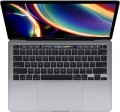Series
Each series combines chips that are similar in general level, purpose, and often also in individual specific features. Moreover, most series include processors of several generations at once, which can differ significantly in actual characteristics. It is worth noting that until recently laptops were equipped almost exclusively with processors from
AMD or
Intel - until in 2020 Apple introduced its own chip
Apple M1 (with updated versions
Apple M1 Pro and
Apple M1 Max),
Apple M2 (2022) with powerful chips
M2 Pro,
M2 Max and
Apple M3,
M3 Pro,
M3 Max (2023). At the moment, the following series are mainly relevant in laptops:
—
AMD Ryzen 3. The most inexpensive series of AMD chips in the Ryzen family (Ryzen 3,
Ryzen 5,
Ryzen 7 and
Ryzen 9) using the Zen microarchitecture. In terms of the general design, Ryzen 3 is similar to its older brothers, but half of the computing cores are deactivated. However, it is quite advanced and is found even in ultrabooks.
...>
— Ryzen 5. The second series based on Zen architecture is a more affordable alternative to Ryzen 7 chips. Ryzen 5 chips have somewhat more limited performance characteristics (in particular, a lower clock frequency and, in some models, L3 cache size). Otherwise, they are completely similar to the “sevens” and are also positioned as high-performance chips for gaming and workstations. See "Ryzen 7" below for more details.
- Ryzen 7. The first series of processors from AMD, built on the Zen microarchitecture. It was introduced in March 2017. In general, Ryzen chips (of all series) are promoted as high-end solutions for gamers, developers, graphic designers and video editors. One of the main differences between Zen and previous microarchitectures was the use of simultaneous multithreading, due to which the number of operations per clock was significantly increased at the same clock frequency. In addition, each core received its own floating-point calculation unit, the speed of the first level cache increased, and the L3 cache capacity in Ryzen 7 chips is 16 MB as standard.
— Atom. Processors specifically designed by Intel for mobile devices (including smartphones). They are mainly used in ultra-compact laptops.
— Core M. Processors designed for portable equipment (in particular, ultra-compact laptops) and characterized by extremely low heat generation, allowing the use of passive cooling systems. They were introduced in 2014 as the first serial chips based on the 14 nm process technology.
— Celeron. The most budget series in the modern line of desktop processors from Intel. However, the latest generations come with integrated graphics.
— Pentium. Budget desktop processors from Intel, slightly superior in performance to Celeron, but not up to the Core i3. Also carry integrated graphics.
— Processor. The entry-level processor line that precedes the Core i3 family in the modern Intel hierarchy. Such chipsets are found in entry-level laptops designed for everyday household or office use, as well as undemanding games.
- Core i3. A series of entry-level and mid-level processors, the most budget series in the Core ix family; however, it outperforms the Pentium and Celeron series.
— Core i5. A series of mid-range processors, both in general and in the Core ix family. The architecture is dual- or quad-core, they have a third-level cache, and many models are also equipped with a built-in graphics chip.
— Core i7. A series of productive processors; before the advent of i9 was the most advanced in the "Core i" family. Core i7 chips have at least 4 cores, large level 3 cache and integrated graphics.
— Core i9. Top-level processors released in 2017; the most powerful line of consumer-grade laptop processors at the time of its introduction, displacing Core i7 chips from this position. They have from 6 cores and a volume cache of level 3.
— Apple. A series of processors from Apple, which debuted in November 2020 along with the release of the next generations of MacBook, MacBook Air and MacBook Pro. In the initial configurations, they are equipped with 8 cores - 4 productive and 4 economical; the latter, according to the creators, consume 10 times less energy than the former. This, combined with the 5 nm process technology, has made it possible to achieve very high energy efficiency and at the same time performance. It is also worth noting that the processors of this series are made according to the system-on-chip scheme: a single module combines a CPU, a graphics adapter, RAM (in the first models - 8 or 16 GB), an NVMe solid-state drive and some other components (in particularly Thunderbolt 4 controllers).Model
The specific model of the processor installed in the laptop, or rather, the processor index within its series (see above). Knowing the full name of the processor (series and model), you can find detailed information on it (up to practical reviews) and clarify its capabilities.
Code name
The code name for CPU installed in the laptop.
This parameter characterizes, first of all, the generation to which the processor belongs, and the microarchitecture used in it. At the same time, chips with different code names can belong to the same microarchitecture/generation; in such cases, they differ in other parameters - general positioning, belonging to certain series (see above), the presence / absence of certain specific functions, etc.
Nowadays, the following code names are relevant in Intel processors:
Coffee Lake,
Comet Lake,
Ice Lake,
Tiger Lake,
Jasper Lake,
Alder Lake,
Raptor Lake (13th Gen),
Alder Lake-N,
Raptor Lake (14th Gen),
Meteor Lake (Series 1),
Raptor Lake (Series 1).
For AMD, the list looks like this:
Zen 2 Renoir,
Zen 2 Lucienne,
Zen 3 Cezanne,
Zen 3 Barcelo,
Zen 3+ Rembrandt,
Zen 3+ Rembrandt R,
Zen 2 Mendocino,
Zen 3 Barcelo R,
Zen 4 Dragon Range,
Zen 4 Phoenix.
Detailed data on different code names can be found in special sources.
Processor cores
The number of cores in the laptop CPU.
The core is a part of the CPU designed to process one thread of instructions (and sometimes more, for such models, see "Number of threads"). Nowadays, in laptops you can find
dual-core,
quad-core,
six-core,
eight-core,
ten-core,
12-core,
14-core CPUs. Also note that recently configurations with different types of cores as part of a single CPU are gaining popularity. Such chips are built on a hybrid architecture that combines high performance and energy-efficient cores. They operate at different clock speeds, have different amounts of pre-installed cache memory and are designed to solve different problems. In particular, such CPUs are found in Intel CPUs (from the 12th generation) and Apple.
Theoretically, more cores means higher performance, especially in parallel computing tasks or when processing multiple resource-intensive tasks at the same time. However, in practice this is true only all else being equal – that is, with a similar microarchitecture, clock frequency, cache volumes and other key parameters. Modern CPUs can vary greatly on these parameters – in itself, a greater number of cores does not mean superiority. This is especially true for dual- and quad-core chips: a mobil
...e-level CPU (for example, Snapdragon, see "CPU series") with 4 cores may well be inferior in capabilities to a dual-core desktop series chip (like Core i3 or i5, which are often used in universal laptops with the "optimal" set of specifications for different tasks). When evaluating CPUs with two or four cores, it is necessary to look, first of all, at the general set of characteristics. But the presence of six, eight or more cores is almost certainly a sign of a powerful CPU. Such equipment is typical mainly for advanced gaming and professional laptops.Total threads
The number of threads supported by the laptop processor.
A thread is a sequence of instructions executed by a processor. Initially, each processor core was designed for one such sequence, and the number of threads was equal to the number of cores. However, in modern CPUs, multithreading technologies are increasingly being used, which allow loading each core with two instruction sequences at once. Such technologies have different names for different manufacturers, but the principle of their operation is the same: during the inevitable pauses in the execution of one of the threads, the kernel does not idle, but works with a different sequence. Accordingly, the total number of threads in such processors is twice the number of cores; such a scheme of work significantly increases productivity (although, of course, it also affects the cost).
CPU speed
The clock speed of the processor installed in the laptop (for multi-core processors, the frequency of each individual core).
Theoretically, a higher clock speed has a positive effect on performance, as it allows the processor to perform more operations per unit of time. However, in fact, the capabilities of the CPU depend on a number of other characteristics — primarily on the series to which it belongs (see above). It even happens that of the two chips, the more performant in the overall result is the slower one. With this in mind, it makes sense to compare by clock frequency only processors of the same series, and ideally, also of the same generation; and the laptop as a whole should be judged by the complex characteristics of the system, as well as by the results of tests (see below).
TurboBoost / TurboCore frequency
Processor clock speed achieved in TurboBoost or TurboCore "overclocking" mode.
Turbo Boost and Turbo Core technologies are used by different manufacturers (Intel and AMD, respectively), but they have the same principle of operation: load distribution from more loaded processor cores to less loaded ones to improve performance. The "overclocking" mode is characterized by an increased clock frequency, and it is indicated in this case.
For more information about clock speed in general, see the relevant paragraph above.
L2 cache
The amount of cache memory level 2 (L2) provided in the laptop processor.
The cache is a processor's own buffer, which stores the most frequently used data from RAM during operation. This speeds up access to them and has a positive effect on system performance. The cache is divided into several levels; the larger the volume of each level, the more data can be stored in it for quick access and the higher the performance (ceteris paribus). Specifically, the L2 cache occupies an intermediate position between the small and fast L1 cache of the first level and the large, but relatively slow L3 cache. Its capacity can reach 12 MB; however, in laptop processors, it is most often noticeably more modest — about 2 – 4 MB.
L3 cache
The amount of cache memory level 3 (L3) provided in the laptop processor.
The cache is a processor's own buffer, which stores the most frequently used data from RAM during operation. This speeds up access to them and has a positive effect on system performance. The cache is divided into several levels; the larger the volume of each level, the more data can be stored in it for quick access and the higher the performance (ceteris paribus). Level 3 cache has the lowest performance and the largest volume — in laptop processors it can reach 16 MB.

